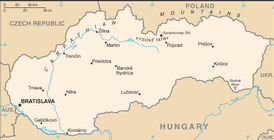Slovakia
 Slovakia is country of Europe located in central Europe.
Slovakia is country of Europe located in central Europe.
Details
| Official Name: | Slovak Republic |
| Capital: | Bratislava |
| Total area: | 49 035 km2 |
| GDP per capita: | $24,284 |
| Native Language: | Slovak |
| Government: | Parliamentary republic |
| Population: | 5,410,836 |
| Major Religion: | Roman Catholicism |
| Monetary Unit: | Euro (EUR) |
Slovakia became an independent state in January 1993 after Czechoslovakia split into its two constituent parts.
The country is in the heart of central Europe, linked to its neighbours by the River Danube. The Carpathian Mountains extend across the northern half of the country and include the High Tatras – a popular skiing destination and home to the country’s highest peak – the 2 655 m Gerlachovsky. The lowlands of the Danube plain provide a fertile farming region producing wheat, barley, potatoes, sugar beet, fruit, tobacco and grapes.
The President, elected by direct popular vote for a five-year term, has limited powers. The country has a single-chamber parliament whose 150 members are elected for four-year terms.
Ethnically, the population is 86% Slovak; Hungarians are the largest minority.
Perched on many hilltops are fortifications that bear witness to Slovakia’s long history of invasions. Bratislava, the coronation place for the kings of Hungary in the past, has a rich heritage of medieval and baroque architecture.
Traditional meals include potato dumplings with sheep’s cheese and cabbage soup with sausages.
Among the best-known Slovaks are Štefan Banič who invented the parachute in 1913, and Andy Warhol, the American-born pop artist, whose parents were from Slovakia.
Health & Welfare
A national low-cost health care system is run by the state for all of Slovakia's inhabitants.
Economy & Jobs
Agriculture, mining, manufacturing, and tourism.
Main Attractions
Bratislava, Spiš castle, The Malá Fatra National Park, and Nízke Tatry alpine mountains.
Economy
The Slovak economy is considered an advanced economy, with the country dubbed the Tatra Tiger
. Slovakia transformed from a centrally planned economy to a market-driven economy. Major privatizations are nearly complete, the banking sector is almost completely in private hands, and foreign investment has risen.
Before the global recession, Slovakia had experienced high and sustained economic growth. In 2007 (with the GDP growth of 10.5%), 2008 (with 5.8%) and 2010 (with 4.2%), Slovakia was the fastest growing economy in the European Union. In 2011 (with the GDP growth of 3.3%), Slovakia was the 2nd fastest growing Eurozone member (after Estonia). According to the European Economic Forecast, released by the European Commission in the spring 2012, Slovakia's predicted growth of 1.8% in 2012, will be the highest in the Eurozone and 4th highest in the EU-27.
Ratio of government debt to GDP in Slovakia is 41 percent, which is the fourth lowest in the Eurozone.
Immigration and residency
If you are interested in moving to the countries, either with a residence permit or by acquiring a citizenship, please contact us, and also get acquainted with the relevant migration documents.